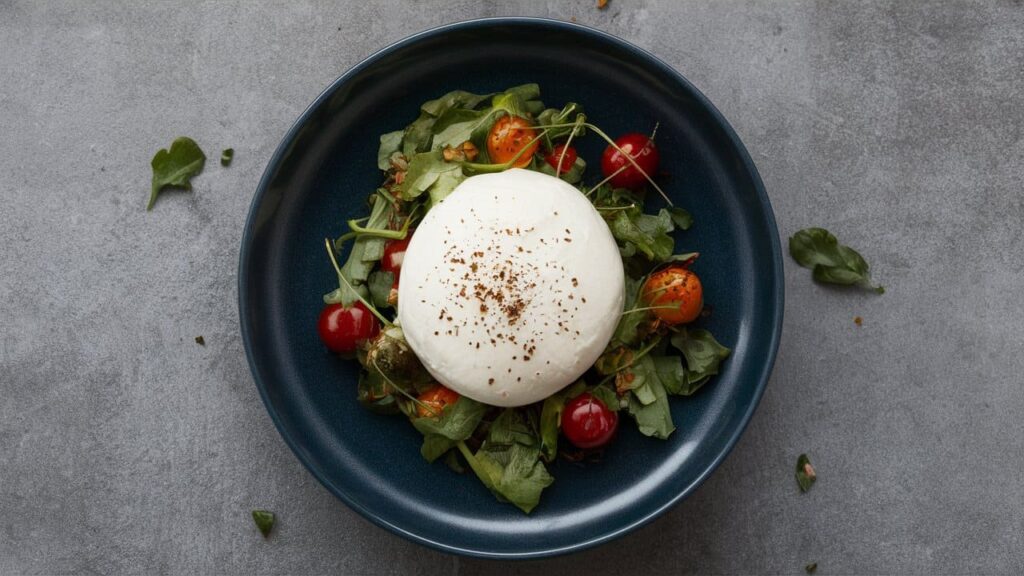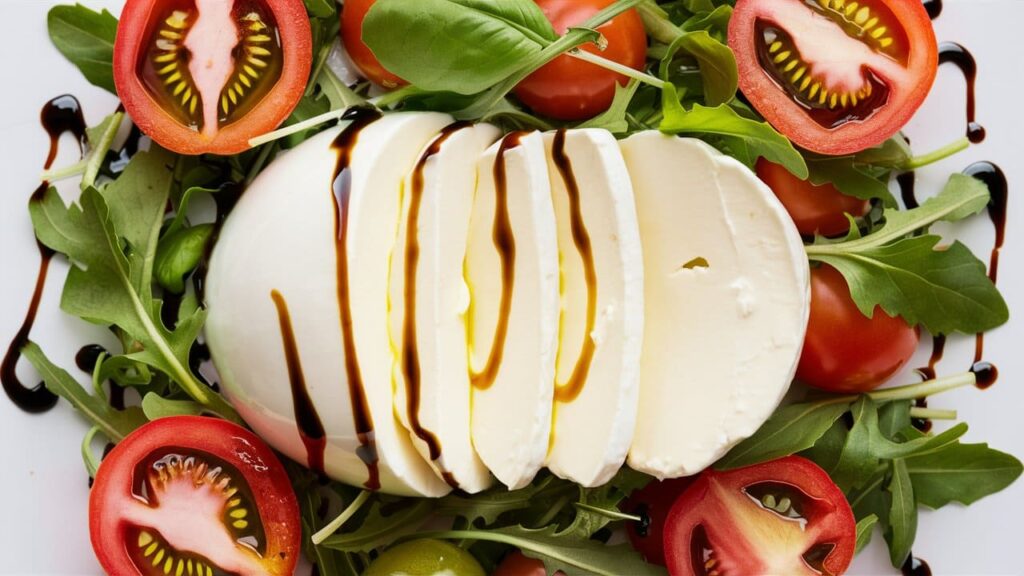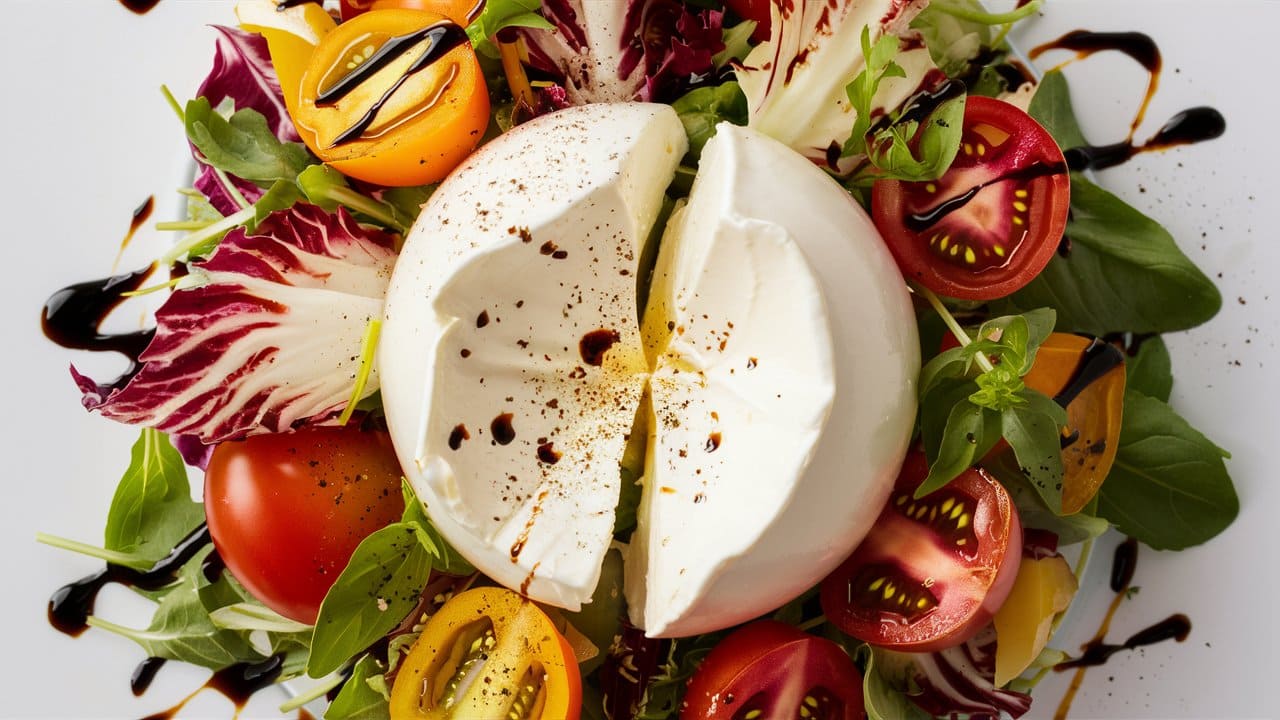Burrata, with its creamy center and delicate mozzarella shell, has become a popular choice for cheese lovers worldwide. But as its popularity grows, so does curiosity about its nutritional value and suitability as burrata a healthy snack. This article explores the health aspects of burrata, its nutritional content, potential health benefits, and considerations for incorporating it into a balanced diet.
Understanding Burrata
Origins and Production
Burrata originated from the Puglia region of Italy, crafted as a way to utilize mozzarella scraps by encasing them in a pouch of stretched mozzarella mixed with cream. This method not only maximized resources but also created a unique cheese celebrated for its richness and flavor.
Nutritional Profile
Burrata is high in fats and calories, primarily because of its cream center. It provides a good amount of proteins and essential nutrients, such as calcium and phosphorus, which are crucial for bone health. However, the high-calorie count and fat content can be a concern for those monitoring their calorie intake.
Texture and Flavor
The outer shell of burrata is solid mozzarella, while the inside contains stracciatella and cream, giving it a soft, creamy texture that is both rich and buttery. This unique texture paired with a fresh, milky flavor makes burrata a delightful addition to many dishes.
Nutritional Benefits of Burrata
Protein Content
Burrata is a good source of high-quality protein, which is essential for muscle repair and growth. The proteins in burrata are complete, containing all nine essential amino acids required by the human body.
Calcium and Phosphorus
The cheese is also rich in calcium and phosphorus, two minerals that play a crucial role in maintaining strong bones and teeth. Regular consumption of calcium-rich foods like burrata can help prevent osteoporosis and support metabolic functions.
Vitamins and Minerals
Burrata contains important vitamins such as Vitamin A, which is vital for skin health and vision, and B vitamins, particularly B12, which is necessary for red blood cell formation and proper nerve function. It also provides zinc and selenium, which are important for immune function and overall health.
Dietary Considerations
Caloric and Fat Content
While burrata offers several nutritional benefits, it is also high in calories and fats, particularly saturated fats, which can be a concern for heart health if consumed in excess. Moderation is key when including burrata in your diet, especially for those watching their weight or managing cholesterol levels.
Lactose Content
As a dairy product, burrata contains lactose, which can be problematic for individuals with lactose intolerance. Those sensitive to lactose should consider their tolerance levels or look for lactose-free alternatives to enjoy similar creamy textures without discomfort.
Sodium Levels
Cheese, including burrata, can be high in sodium, which may lead to increased blood pressure and other cardiovascular issues if consumed in large amounts. Watching portion sizes and balancing out with low-sodium foods throughout the day can help mitigate this concern.
Incorporating Burrata into a Healthy Diet
As Part of Balanced Meals
Burrata can be part of a healthy snack diet when consumed in moderation. Pairing it with nutrient-rich foods like tomatoes, leafy greens, and whole grains can balance out the meal, providing fiber, vitamins, and antioxidants alongside the richness of burrata.
Burrata Healthy Snack Ideas
For a healthy snack, serve a small portion of burrata with fresh fruits, nuts, or seeds. These combinations can provide a good balance of proteins, fats, and carbohydrates, along with dietary fiber and essential nutrients.
Creative Culinary Uses
Burrata can be used creatively in cooking to add flavor and texture without overindulging. Use it to top a vegetable bake, melt into a risotto, or add to a summer salad for a touch of luxury without making the dish too heavy.
Health Considerations and Moderation Strategies for Enjoying Burrata
Burrata can be a nutritious addition to your diet, but like many rich foods, it should be enjoyed in moderation. This section outlines specific health considerations related to burrata consumption and offers strategies to integrate this delectable cheese into a balanced diet effectively.
Health Considerations When Consuming Burrata
Heart Health and Fats
While burrata provides a delightful creamy texture and flavor, its high saturated fat content can pose risks to heart health if consumed excessively. Diets high in saturated fats have been linked to higher cholesterol levels, which increase the risk of heart disease and stroke.
Weight Management
The calorie density of burrata is also a consideration, particularly for those managing their weight. Burrata is energy-dense, meaning it provides a significant amount of calories in a small portion, which can easily contribute to caloric surplus and weight gain if not monitored.
Digestive Health
For individuals with lactose intolerance, consuming burrata can lead to digestive distress, including bloating, gas, and diarrhea. This is due to the lactose content in burrata, which some people’s digestive systems cannot break down effectively.
Moderation and Portion Control
Serving Size Recommendations
Understanding appropriate portion sizes can help manage the intake of calories and saturated fats. A healthy serving size of burrata might be about the size of a golf ball (approximately 2 ounces or 56 grams), enough to enjoy the flavor while keeping the calorie and fat intake in check.
Incorporating Burrata Sparingly
Instead of making burrata the main component of a dish, use it as a garnish or a minor addition to enhance flavors without overdoing the portion. For example, a small amount of burrata can be added to a salad or a vegetable dish to enrich the meal without overwhelming it with calories.
Frequency of Consumption
Limiting the frequency of burrata consumption can also help maintain a balanced diet. Enjoying burrata as an occasional treat rather than a regular part of daily meals can make it easier to manage overall fat and calorie intake.
Alternative burrata a Healthy Snack Options
Plant-Based Alternatives
For those seeking lower-calorie or dairy-free alternatives, exploring plant-based cheese options can be beneficial. Nut-based cheeses, such as those made from almonds or cashews, can offer a creamy texture with potentially lower levels of saturated fats and no lactose.
Other Low-Fat Cheese Options
Consider incorporating other low-fat cheeses into your diet as alternatives to burrata. Options like mozzarella, cottage cheese, or feta provide the calcium and protein benefits of dairy without as much saturated fat, making them suitable for more frequent consumption.
Combining with Nutrient-Dense Foods
Pairing burrata with foods high in fiber, vitamins, and antioxidants—such as fruits, vegetables, and whole grains—can balance out the meal. This not only enhances the nutritional value of the snack or dish but also contributes to satiety, which can help with weight management.

Creative and Healthy Ways to Enjoy Burrata
Burrata’s rich and creamy texture makes it a versatile ingredient in many dishes. This section explores various creative and healthy ways to incorporate burrata into your meals, ensuring you can enjoy its luxurious flavor while maintaining a balanced diet.
Incorporating Burrata into Balanced Meals
Burrata and Vegetable Pairings
Pairing burrata with fresh vegetables not only enhances its flavor but also boosts the nutritional value of your meal. Vegetables are low in calories and high in vitamins, minerals, and fiber, which can help balance the richness of burrata.
- Grilled Vegetables: Combine burrata with grilled zucchini, bell peppers, and eggplant. The smoky flavor of the grilled vegetables complements the creamy burrata perfectly.
- Fresh Salads: Create a vibrant salad with mixed greens, cherry tomatoes, cucumber, and a dollop of burrata. Dress with a light vinaigrette made from olive oil and lemon juice to keep it healthy and refreshing.
- Roasted Root Vegetables: Serve burrata alongside roasted root vegetables like carrots, beets, and sweet potatoes. The sweetness of the roasted vegetables pairs beautifully with the creamy texture of the cheese.
Burrata with Whole Grains
Integrating whole grains into your meals with burrata can add fiber and essential nutrients, promoting a balanced diet and sustained energy levels.
- Quinoa Bowls: Create a wholesome quinoa bowl with burrata, roasted vegetables, and a sprinkle of seeds or nuts. Quinoa’s nutty flavor and fluffy texture provide a perfect base for the rich cheese.
- Farro Salads: Mix farro with arugula, roasted cherry tomatoes, and burrata. Farro’s chewy texture and nutty taste make it a great partner for burrata in a hearty salad.
- Brown Rice and Burrata: Top a serving of brown rice with steamed or sautéed vegetables and a portion of burrata. Add a squeeze of lemon juice and some fresh herbs for extra flavor.
Burrata as a Protein Boost
Burrata can also serve as a protein component in various dishes, contributing to muscle repair and overall satiety.
- Stuffed Chicken Breast: Stuff chicken breasts with a mixture of burrata, spinach, and herbs. Bake until the chicken is cooked through and the cheese is melted, creating a delicious and protein-rich main course.
- Pasta with Burrata: While pasta might seem indulgent, using whole grain or vegetable-based pasta can make it a healthier option. Top with a light tomato sauce, fresh basil, and burrata for a balanced meal.
- Burrata and Beans: Create a hearty bean salad with cannellini beans, cherry tomatoes, red onion, and basil, topped with burrata. Beans add fiber and protein, complementing the creamy cheese.
Healthy Snack Ideas Featuring Burrata
Simple Burrata and Fruit
Pairing burrata with fresh fruit can create a delightful and nutritious snack that satisfies sweet and savory cravings.
- Burrata and Berries: Serve burrata with a mix of fresh berries like strawberries, blueberries, and raspberries. The tartness of the berries balances the richness of the cheese.
- Peach and Burrata: Slice ripe peaches and serve with burrata, a drizzle of honey, and a sprinkle of fresh mint. This combination is both refreshing and satisfying.
- Apple Slices and Burrata: Apple slices paired with burrata and a touch of balsamic vinegar create a snack that’s both crisp and creamy.
Burrata on Whole Grain Toast
Whole grain toast topped with burrata can be a quick and nutritious snack or light meal.
- Avocado and Burrata Toast: Spread mashed avocado on whole grain toast and top with burrata, a sprinkle of chili flakes, and a squeeze of lemon juice. This combination offers healthy fats, fiber, and protein.
- Tomato and Basil Toast: Layer slices of fresh tomato and basil leaves on toast with burrata. Drizzle with a bit of olive oil and balsamic reduction for added flavor.
- Mushroom and Burrata Toast: Sauté mushrooms with garlic and herbs, then place them on toast with burrata. The earthiness of the mushrooms pairs wonderfully with the creamy cheese.
Burrata with Nuts and Seeds
Adding nuts and seeds to burrata snacks provides additional nutrients and a satisfying crunch.
- Burrata and Pistachios: Top burrata with chopped pistachios and a drizzle of honey. This sweet and savory combination is perfect for a quick snack.
- Burrata and Sunflower Seeds: Sprinkle sunflower seeds over burrata served with fresh cucumber slices. This snack is light, crunchy, and nutritious.
- Burrata and Walnut Salad: Create a simple salad with mixed greens, walnuts, and burrata. Add a light vinaigrette for a refreshing and healthy dish.

healthy Benefits and Final Considerations for Burrata as a Snack
In this final section, we will summarize the health benefits of burrata and provide some final considerations for enjoying this luxurious cheese as part of a balanced diet. We will also discuss how to incorporate burrata into various dietary plans and conclude with practical tips for making the most of its nutritional profile.
Health Benefits of Burrata
Rich in Protein and Calcium
Burrata is an excellent source of protein, which is essential for muscle repair and growth, as well as overall cellular function. The protein content in burrata can help maintain muscle mass and provide the necessary amino acids for bodily functions. Additionally, burrata is rich in calcium, which is crucial for maintaining strong bones and teeth. Calcium also plays a role in nerve transmission, muscle function, and cardiovascular health.
Provides Essential Vitamins and Minerals
Burrata contains important vitamins such as Vitamin A, which is vital for maintaining healthy vision, skin, and immune function. It also provides B vitamins, particularly B12, which are essential for red blood cell formation and neurological function. The presence of zinc and selenium in burrata contributes to immune support and overall well-being.
Satiating and Satisfying
Due to its rich, creamy texture and higher fat content, burrata can be a satiating snack that helps keep you full and satisfied. This can prevent overeating and help maintain a balanced diet by reducing the temptation to snack on less nutritious foods.
Final Considerations for Enjoying Burrata
Moderation is Key
While burrata has several nutritional benefits, it is important to consume it in moderation due to its high calorie and fat content. Including burrata as an occasional treat rather than a daily staple can help manage calorie intake and support overall health goals.
Pairing with Nutritious Foods
Combining burrata with nutrient-dense foods like fresh vegetables, fruits, whole grains, and nuts can enhance its nutritional profile and provide a balanced snack or meal. These pairings add vitamins, minerals, fiber, and antioxidants, making the meal more wholesome and nutritious.
Incorporating into Various Diets
Burrata can fit into various dietary plans, including Mediterranean, low-carb, and vegetarian diets. For those on a Mediterranean diet, burrata can be enjoyed with olive oil, tomatoes, and whole grains. In a low-carb diet, it pairs well with leafy greens and high-protein ingredients. Vegetarians can enjoy burrata in place of meat for a protein-rich option.
Practical Tips for Maximizing Burrata’s Nutritional Profile
Mindful Eating
Practicing mindful eating can enhance your enjoyment of burrata. Savor each bite and appreciate the creamy texture and rich flavor.
Balancing with Physical Activity
Incorporating physical activity into your routine can help balance the higher calorie content of burrata. Regular exercise supports overall health and can help manage weight, making occasional indulgences more sustainable.
Choosing High-Quality Burrata
Opt for high-quality burrata made from fresh, high-quality milk. Artisan burrata often has a better flavor and texture, and knowing the source of your cheese can ensure it is made with care and good practices.
Conclusion
Burrata, with its creamy center and rich flavor, can be a delightful and nutritious part of a balanced diet when consumed in moderation. By understanding its nutritional benefits and pairing it with nutrient-dense foods, you can enjoy burrata as a healthy snack or addition to meals. Remember to balance indulgence with mindful eating and physical activity to maintain overall health. With these considerations in mind, you can savor the luxurious taste of burrata while supporting your dietary and health goals.
You can get more recipes from here:

